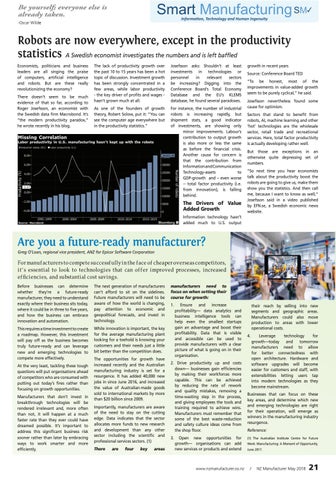Be yourself; everyone else is already taken. -Oscar Wilde
Robots are now everywhere, except in the productivity statistics A Swedish economist investigates the numbers and is left baffled Economists, politicians and business leaders are all singing the praise of computers, artificial intelligence and robots. But are these really revolutionizing the economy? There doesn’t seem to be much evidence of that so far, according to Roger Josefsson, an economist with the Swedish data firm Macrobond. It’s “the modern productivity paradox,” he wrote recently in his blog.
The lack of productivity growth over the past 10 to 15 years has been a hot topic of discussion. Investment growth has been strongly concentrated in a few areas, while labor productivity - the key driver of profits and wages hasn’t grown much at all.
Josefsson asks: Shouldn’t at least investments in technologies or personnel in relevant sectors be increasing? Digging into the Conference Board’s Total Economy Database and the EU’s KLEMS database, he found several paradoxes.
As one of the founders of growth theory, Robert Solow, put it: “You can see the computer age everywhere but in the productivity statistics.”
For instance, the number of industrial robots is increasing rapidly, but shipment stats, a good indicator of investments, are showing only minor improvements. Labour’s contribution to output growth is also more or less the same as before the financial crisis. Another cause for concern is that the contribution from Information and Communication Technology-assets to GDP-growth and – even worse -- total factor productivity (i.e. from innovation), is falling behind.
The Drivers of Value Added Growth
growth in recent years Source: Conference Board TED “To be honest, most of the improvements in value-added growth seem to be purely cyclical,” he said. Josefsson nevertheless found some cause for optimism. Sectors that stand to benefit from robots, AI, machine learning and other ‘hot’ technologies are the wholesale sector, retail trade and recreational services. Here, total factor productivity is actually developing rather well. But those are exceptions in an otherwise quite depressing set of numbers. “So next time you hear economists talk about the productivity boost the robots are going to give us, make them show you the statistics. And then call me, because I want to know as well,” Josefsson said in a video published by EFN.se, a Swedish economic news website.
Information technology hasn’t added much to U.S. output
Are you a future-ready manufacturer? Greg O’Loan, regional vice president, ANZ for Epicor Software Corporation
For manufacturers to compete successfully in the face of cheaper overseas competitors, it’s essential to look to technologies that can offer improved processes, increased efficiencies, and substantial cost savings. Before businesses can determine whether they’re a future-ready manufacturer, they need to understand exactly where their business sits today, where it could be in three to five years, and how the business can embrace innovation and automation.
The next generation of manufacturers can’t afford to sit on the sidelines. Future manufacturers will need to be aware of how the world is changing, pay attention to economic and geopolitical forecasts, and invest in technology.
This requires a time investment to create a roadmap. However, this investment will pay off as the business becomes truly future-ready and can leverage new and emerging technologies to compete more effectively.
While innovation is important, the key for the average manufacturing plant looking for a toehold is knowing your customers and their needs just a little bit better than the competition does.
At the very least, tackling these tough questions will put organisations ahead of competitors who are consumed with putting out today’s fires rather than focusing on growth opportunities. Manufacturers that don’t invest in breakthrough technologies will be rendered irrelevant and, more often than not, it will happen at a much faster rate than they ever could have dreamed possible. It’s important to address this significant business risk sooner rather than later by embracing ways to work smarter and more efficiently.
The opportunities for growth have increased recently and the Australian manufacturing industry is set for a resurgence. It has added 40,000 new jobs in since June 2016, and increased the value of Australian-made goods sold to international markets by more than $20 billion since 2009. Importantly, manufacturers are aware of the need to stay on the cutting edge. Data indicates that the sector allocates more funds to new research and development than any other sector including the scientific and professional services sectors. (1) There
are
four
key
areas
manufacturers need to focus on when setting their course for growth: 1.
Ensure and increase profitability— data analytics and business intelligence tools can help even the smallest startups gain an advantage and boost their profitability. Data that is visible and accessible can be used to provide manufacturers with a clear picture of what is going on in their organisation.
2. Drive productivity up and costs down— businesses gain efficiencies by making their workforces more capable. This can be achieved by reducing the rate of rework and quality mistakes, removing a time-wasting step in the process, and giving employees the tools and training required to achieve wins. Manufacturers must remember that some of the best waste-reduction and safety culture ideas come from the shop floor. 3.
Open new opportunities for growth— organisations can add new services or products and extend
www.nzmanufacturer.co.nz
their reach by selling into new segments and geographic areas. Manufacturers could also move production to areas with lower operational costs. 4.
Leverage technology for growth—today and tomorrow manufacturers need to allow for better connectedness with open architecture. Hardware and software upgrades will become easier for customers and staff, with extensibilities letting users tap into modern technologies as they become mainstream.
Businesses that can focus on these key areas, and determine which new and emerging technologies are right for their operation, will emerge as winners in the manufacturing industry resurgence. Reference: (1) The Australian Institute Centre for Future Work: Manufacturing: A Moment of Opportunity. June 2017.
/
NZ Manufacturer May 2018
21
